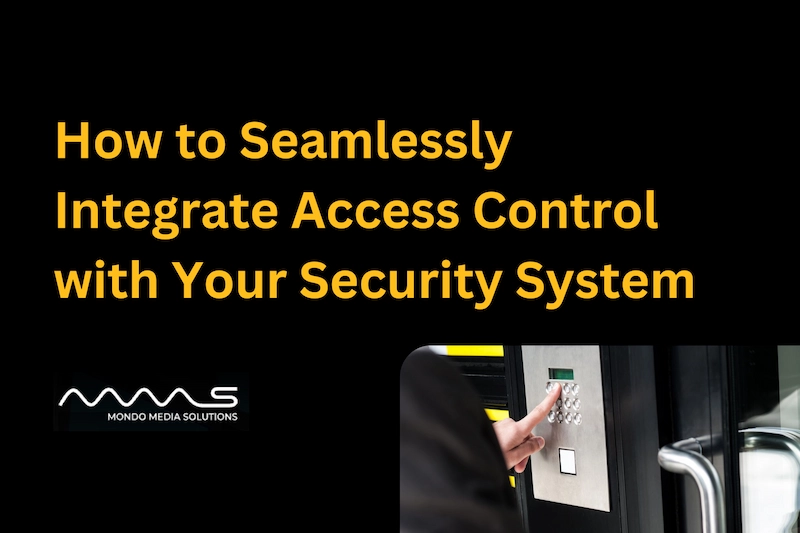Ensuring the security of your business requires more than just locked doors or standalone cameras. Integrated security systems are the gold standard for protecting your assets, employees, and visitors. The ability to integrate access control with your security system allows for seamless management, enhanced security, and a centralized approach to controlling who has access to your premises.
If you’ve been considering upgrading your security, this guide will walk you through the best practices for integration and explain why it’s time to make the switch to integrated access control systems.
What is Access Control Integration?
Access control integration involves connecting your access control systems with other security tools like CCTV, alarm systems, or video surveillance to create a unified platform. This allows different systems to communicate and work together for enhanced security and operational efficiency.
For example, integrating access control and video surveillance means you can live footage of who enters and exits your premises, cross-referencing it with access logs in real time.
Explore our access control installation services to learn how integration works for different business needs.
Why Integrate Access Control with Your Security System?
1. Enhanced Security and Real-Time Feed
One of the main advantages of integrated access control systems is the ability to oversee all security activities in real-time. When access control is linked to your CCTV system, you can instantly verify the identity of anyone entering a restricted area. This immediate insight helps prevent unauthorized access and enhances the overall safety of your premises.
2. Centralized Control for Efficiency
Managing multiple security systems separately can be time-consuming and prone to errors. Integrated solutions consolidate everything into one platform, making it easier for administrators to oversee, control, and update access permissions. Whether you’re granting access to a contractor or locking down specific zones, centralized control saves time and improves operational efficiency.
3. Cost-Effective and Scalable Solutions
Integrating access control in security systems eliminates the need for redundant hardware and reduces long-term maintenance costs. Additionally, these systems are scalable, which means you can expand or upgrade them as your business grows, without replacing the entire setup.
Recommended Read: Factors affect the cost of an Access Control System
Best Practices for Access Control Integration
1. Start with a Security Audit
Before integrating systems, conduct a thorough security audit of your premises. Identify potential vulnerabilities, high-traffic areas, and critical zones that require advanced security measures. A comprehensive assessment ensures your access control integration is tailored to your specific needs.
2. Choose Compatible Systems
Not all security tools are built to work together. When selecting hardware and software, ensure they are compatible with each other and offer integration capabilities. Look for providers that specialize in integrated access control solutions to avoid unnecessary technical issues.
3. Leverage Automation Features
Automation is a game-changer in modern security. Integrated systems can trigger automatic responses based on events. For example, if an alarm is triggered, the system can automatically lock all doors and alert security personnel. This level of automation enhances response times and ensures safety in emergencies.
Learn more about the benefits of automation in access control.
How to Integrate Access Control with CCTV and Video Surveillance?
Combining access control and CCTV systems creates a robust security network. Here’s how it works:
- Synchronized Verification: Pair access logs with video footage to confirm the identity of users entering restricted areas.
- Triggered Alerts: Set up alerts to notify you of suspicious activity, such as multiple failed access attempts.
- Evidence Collection: In the case of security incidents, having synchronized data from both systems makes investigations more efficient.
Common Challenges and How to Overcome Them
1. Integration Complexity
Integrating multiple systems can be complex, especially if they come from different manufacturers. Partnering with an experienced provider of access control installation services ensures a smooth integration process and minimizes technical hurdles.
2. Ensuring Data Privacy and Security
With integrated systems, protecting sensitive data becomes even more critical. Choose systems that use encryption and follow industry standards for data security to safeguard access logs and video footage.
Benefits of Access Control Integration for Businesses
1. Improved Employee Safety
Integrated systems provide a safer environment by controlling access to critical areas and overseeing activities. Employees can feel secure knowing that potential threats are mitigated in real-time.
2. Better Compliance with Regulations
Many industries, like healthcare and finance, have strict security regulations. Integrated systems make it easier to meet these requirements by providing detailed access logs, automated reporting, and advanced control features.
Why Choose Us for Access Control Integration?
At Mondo Media Solutions, we specialize in delivering integrated access control systems tailored to your business needs. From conducting security audits to implementing scalable solutions, our team ensures a seamless integration process.
Contact us today to explore our access control integration services and elevate your security system.
Conclusion
The ability to integrate access control with security systems is transforming how businesses protect their assets and people. By combining access control with CCTV, video surveillance, and automation, you can create a unified security network that is efficient, scalable, and cost-effective.
If you’re ready to take your security to the next level, Mondo Media Solutions can help you design and implement a customized integrated access control.
